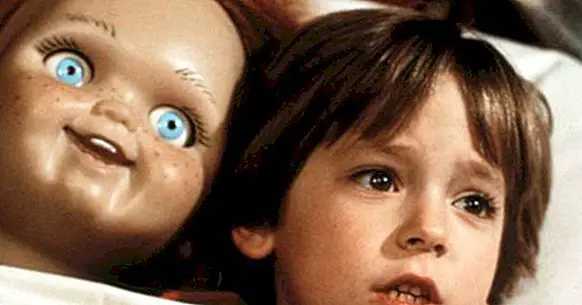Pediophobia: the fear of dolls (causes and symptoms)
There are different types of phobias, and some of these can be really strange . The hexakosioihexekontahexafobia or fear of the number 666, the coulrophobia or fear of clowns or turofobia or fear of cheese, are some examples. Another phobia that may seem strange is pediophobia or fear of dolls.
The dolls are adorable objects that remind us of childhood and innocence, but some people may suffer an irrational fear of these toys that represent the human figure although in smaller dimensions. In the cinema, some films have based their stories around these objects, sometimes possessed or possessed in their scripts.
What is pediophobia
The pediophobia is the irrational fear of the dolls, and not only the dolls with diabolic image, but any of them . In many cases, in addition, pediofóbicos can also feel a great fear of robots and mannequins. This phobia should not be confused with pedophobia, which is the fear of children.
Sigmund Freud thought that this disorder had its origin in the fear that this object will come alive. However, to understand the pediophobia, which is part of the phobic disorders, the behaviorist seems to be more effective, because phobias usually originate from classical conditioning.
A phobia similar to coulrophobia
Like clowns, dolls are associated with children and produce different sensations and emotions in us. We usually associate them with fun and endearing moments; and the dolls are ideal as a form of entertainment.
But despite this image we have of clowns and dolls, these figures are also associated with negative and unpleasant images, leading to cause real fear. Clowns and dolls are also horror figures in the world of cinema, and have acted as assassins in some movies. In the case of clowns, reality has surpassed fiction, and John Wayne Gacy is known, the grim case of the murderous clown, who disguised himself to commit his crimes.
What causes a phobia
A phobia is an irrational fear towards some object, situation or activity, that is, towards a phobic stimulus. It is an anxiety disorder and can be very disabling. People with some type of phobia usually avoid phobic stimulation because of the great discomfort that this makes them feel.
Phobias usually develop due to a series of environmental factors, although some experts say that genetic predisposition is crucial. However, the hypothesis of environmental factors has more weight, and the cause of someone developing a phobic disorder is usually a traumatic experience lived around that stimulus. Generally, this precipitating event occurs in childhood, and the phobia appears by associative learning or classical conditioning.
The dolls, likewise, can provoke the phobia indirectly, since in some films they can represent evil, being possessed or being murderers, but they can also be associated with voodoo and, therefore, with black magic or witchcraft.
And is that many movies or science fiction novels have as protagonists diabolic dolls or evil for example, Chucky movies, so some children are terrified by this image so evil.
Symptoms of doll phobia
Individuals who suffer this irrational fear of dolls they feel great anxiety or discomfort when being near them, when seeing them on television or imagining them . Therefore, fear and panic attached to anxiety are the main symptoms. In addition, like any type of phobia, the person suffering from this disorder avoids the feared stimulus, and performs behaviors so as not to have to be exposed to the source of discomfort.
The symptoms of phobias are practically the same for all phobic disorders, and they are the following:
- Dry mouth
- Loss of concentration and disorientation
- Excess of sweating
- Terror and intense fear
- Feeling of shortness of breath and hyperventilation
- Catastrophic thinking
- Anxiety and anguish
- Increased heart rate and pulse acceleration
- Intestinal discomfort
- Muscle tension
- Behaviors to avoid the feared stimulus
Treatment of this disorder
Since this disorder can become disabling and cause an intense feeling of discomfort, it is necessary to go to a psychology professional to be able to overcome it . Generally, the psychologist will perform a treatment that includes cognitive behavioral therapy techniques, such as systematic desensitization or expository techniques; however, some professionals also make use of mindfulness or hypnotherapy.
Without a doubt, systematic desensitization is the most popular technique to overcome the fear of dolls or pediophobia. This technique involves slow and gradual exposure to the feared stimulus and fosters more useful coping skills in the patient. For example, the patient may start by looking at pictures of dolls and dolls, reading books or watching movies about these toys. Once they are able to control this fear in these situations, they can expose themselves to the real feared stimulus. In severe cases, treatment may include drugs for anxiety, but never as an alternative to psychological therapy.
Some apps to treat phobias
With the inclusion of new technologies in our lives, these not only have a recreational use, but also can be used for clinical or psychotherapeutic purposes . In recent years, different apps have appeared that help overcome phobias.
If you suffer from some kind of phobia, our article: "8 apps to treat phobias and fears from your smartphone" may interest you. " So check it out if you wish.



















